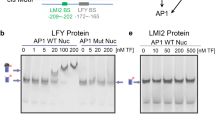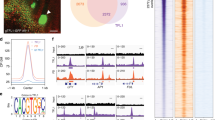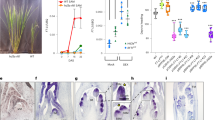Abstract
Flowering plants exhibit two types of inflorescence architecture: determinate and indeterminate. The centroradialis mutation causes the normally indeterminate inflorescence of Antirrhinum to terminate in a flower. We show that centroradialis is expressed in the inflorescence apex a few days after floral induction, and interacts with the floral-meristem-identity gene floricaula to regulate flower position and morphology. The protein CEN is similar to animal proteins that associate with lipids and GTP-binding proteins. We propose a model for how different inflorescence structures may arise through the action and evolution of centroradialis.
This is a preview of subscription content, access via your institution
Access options
Subscribe to this journal
Receive 51 print issues and online access
$199.00 per year
only $3.90 per issue
Buy this article
- Purchase on Springer Link
- Instant access to full article PDF
Prices may be subject to local taxes which are calculated during checkout
Similar content being viewed by others
References
Weberling, F. Morphology of Flowers and Inflorescences (Cambridge Univ. Press, 1989).
Coen, E. A. Rev. Pl. Physiol. Pl. molec. Biol. 42, 241–279 (1991).
Weigel, D. & Nilsson, O. Nature 377, 495–550 (1995).
Mandel, M. A. & Yanofsky, M. F. Nature 377, 522–524 (1995).
Coen, E. S. & Nugent, J. M. Development (suppl.) 107–116 (1994).
Stebbins, G. L. Flowering Plants, Evolution above the Species Level (Harvard Univ. Press, MA, 1974).
Kuckuck, H. & Schick, R. Z. indukt. Abstanim. -u. Vereblehre 56, 51–83 (1930).
Stubbe, H. Genetik und Zytologie von Antirrhinum L. sect Antirrhinum (VEB Gustav Frischer, Jena, 1966).
Coen, E. S. et al. Cell 63, 1311–1322 (1990).
Huijser, P. et al. EMBO J. 11, 1239–1250 (1992).
Carpenter, R. et al. Pl. Cell 7, 2001–2011 (1995).
Carpenter, R. & Coen, E. S. Genes Dev. 4, 1483–1493 (1990).
Coen, E. S. & Meyerowitz, E. M. Nature 353, 31–37 (1991).
Keeble, F., Pellew, C. & Jones, W. N. New Phytol 9, 68–77 (1910).
Shannon, S. & Meeks-Wagner, D. R. Pl. Cell 3, 877–892 (1991).
Alvarez, J., Guli, C. L., Yu, X.-H. & Smyth, D. R. Pl J. 2, 103–116 (1992).
Grandy, D. K. et al. Molec. cell Endocr. 4, 1370–1376 (1990).
Bucquoy, S., Jolles, P. & Schoentgen, F. Eur. J. Biochem 225, 1203–1210 (1994).
Schwarz-Sommer, Z. et al. EMBO, J. 11, 251–263 (1992).
Bradley, D., Carpenter, R., Sommer, H., Hartley, N. & Coen, E. Cell 72, 85–95 (1993).
Coen, E. S., Robbins, T. P., Almeida, J., Hudson, A. & Carpenter, R. in Mobile DNA (eds Berg, D. E. & Howe, M. M.) 413–416 (American Society for Microbiology, Washington DC, 1989).
Jameson, B. & Wolf, H. Comput. Appl. Biosci. 4, 181–186 (1988).
Pikielny, C. W., Hasan, G., Rouyer, F. & Rosbash, M. Neuron 12, 35–49 (1994).
Lobos, E. et al. Molec. Biochem. Parasitol. 39, 135–146 (1990).
Tripp, M. L., Bouchard, R. A. & Pinon, R. Molec. Microbiol. 3, 1319–1327 (1989).
Robinson, L. C. & Tatchell, K. Molec. gen. Genet. 230, 241–250 (1991).
Fobert, P. R., Coen, E. S., Murphy, G. J. P. & Doonan, J. H. EMBO J. 13, 616–624 (1994).
Williams, M. H. & Green, P. B. Protoplasma 147, 77–79 (1988).
Altschul, S. F., Gish, W., Miller, W., Myers, E. W. & Lipman, D. J. J. molec. Biol. 215, 403–410 (1990).
Luo, D., Coen, E. S., Doyle, S. & Carpenter, R. Pl. J. 1, 59–69 (1991).
Simon, R., Carpenter, R., Doyle, S. & Coen, E. Cell 78, 99–107 (1994).
Frohman, M. A., Dush, M. K. & Martin, G. R. Proc. natn. Acad. Sci. U.S.A. 85, 8998–9002 (1988).
Bradley, D., Vincent, C., Carpenter, R. & Coen, E. Development (in the press).
Hammer, K., Knüpffer, S. & Knüffer, H. Kulturpflanze 38, 91–117 (1990).
Author information
Authors and Affiliations
Rights and permissions
About this article
Cite this article
Bradley, D., Carpenter, R., Copsey, L. et al. Control of inflorescence architecture in Antirrhinum. Nature 379, 791–797 (1996). https://doi.org/10.1038/379791a0
Received:
Accepted:
Issue Date:
DOI: https://doi.org/10.1038/379791a0
This article is cited by
-
A novel single nucleotide mutation of TFL1 alters the plant architecture of Gossypium arboreum through changing the pre-mRNA splicing
Plant Cell Reports (2024)
-
Identification, evolution and expression analyses of the whole genome-wide PEBP gene family in Brassica napus L.
BMC Genomic Data (2023)
-
Molecular screening reveals a photoperiod responsive floral regulator in sugarcane
Theoretical and Experimental Plant Physiology (2023)
-
An insight into the gene-networks playing a crucial role in the cotton plant architecture regulation
The Nucleus (2023)
-
Fine mapping of BnDM1—the gene regulating indeterminate inflorescence in Brassica napus
Theoretical and Applied Genetics (2023)
Comments
By submitting a comment you agree to abide by our Terms and Community Guidelines. If you find something abusive or that does not comply with our terms or guidelines please flag it as inappropriate.



